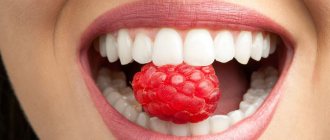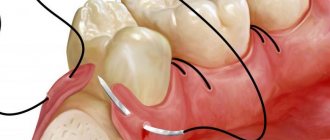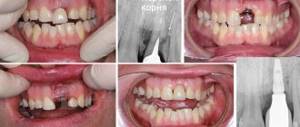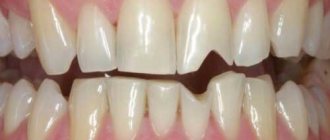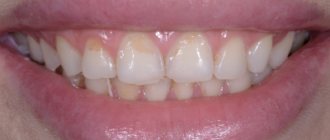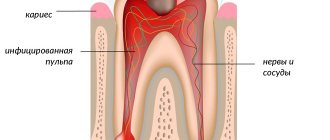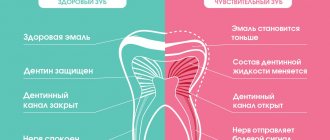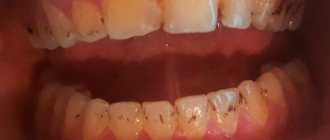How and why hard plaque forms on teeth
The oral mucosa is simply teeming with all kinds of bacteria, the quantities of which are in a certain ratio to each other. When the bacterial balance is disturbed, some microbes can multiply excessively and provoke all kinds of dental ailments. If for some reason teeth brushing has become poor and irregular, then a concentrate of 200 billion different bacteria will immediately react to this by the appearance of a mineralized film. It actively forms within 15 hours, and within a week it becomes quite noticeable plaque, which will turn into hard tartar in six months.
Types of formations, how tartar manifests itself
Depending on the location of hard plaque, it is classified as stones:
- Above the gums, which are visually noticeable and look like dark or yellow plaque. Supragingival deposits form above the gum line, so they are easily identified and can be easily removed in dental clinics.
- Under the gums, which form under the gums, are therefore not noticeable during a simple examination and at first glance the teeth look completely healthy. Hard dental subgingival plaque can manifest as blue gums, swelling and bleeding. Stone in the space between the gum and tooth root often provokes local suppuration. The presence of such hard deposits on the teeth may indicate periodontitis, the process of destruction of the bone surrounding the tooth, etc. Identifying and removing this type of tartar is quite a difficult task.
Many people mistakenly believe that tartar is just an aesthetic problem. But, unfortunately, hard plaque (where there is a mass of pathogenic bacteria) begins to actively release toxins and stimulants of pathogenic processes in the gum area. Basic signs of gum tissue inflammation include:
- Sore gums;
- Bluish tint or redness of the gums;
- Presence of tooth mobility;
- Bleeding gums during normal use of a toothbrush for oral hygiene;
- Putrid odor from the mouth, caused by the outflow of purulent contents from periodontal pockets.
If any of the signs appear, you should contact your dentist so as not to aggravate the inflammatory process, stop it and prevent tooth loss.
How to avoid tartar formation
Tartar prevention is a simple and affordable procedure. It will help protect not only from mineral plaque, but also from other dental diseases. To avoid the appearance of tartar, you must:
- Brush your teeth regularly. Twice a day, morning and evening, 2-3 minutes. You shouldn’t lean on the toothbrush so as not to scratch the enamel, but you shouldn’t move it like a feather either. Select the optimal pressing force;
- Use a variety of oral hygiene products. Flosses will help remove mineral plaque from the interdental spaces, irrigators - from periodontal (gum) pockets, rinses - get rid of harmful microorganisms;
- Use quality home hygiene products. Don’t skimp on toothpaste—dentist services can still cost more than the 50-100 rubles you managed to save;
- Eat 4-6 times a day, but little by little. You should not snack every few tens of minutes, especially snacks like chips, cookies or candy;
- Make it a habit to rinse your mouth with water after every meal. This will help wash away microorganisms, bacterial plaque and food particles;
- Eat more solid, healthy foods. For example, snack on carrots and apples. But you should refuse soft and high-calorie foods (cookies, cakes, etc.);
- Visit your dentist regularly.
These tips will help protect not only from tartar, but also from other dental problems. They will also have a positive effect on the gastrointestinal tract. This means that the rest of the body will say “Thank you.”
Our dental center will not only help you deal with tartar through professional cleaning using modern equipment, but will also teach you proper daily oral hygiene. The procedure will take about an hour, will be painless and calm, and immediately after its completion you will be able to delight those around you with your beautiful, confident and snow-white smile!
Methods for getting rid of hardened plaque
Dentistry offers several ways to clean teeth from plaque and deposits. They are distinguished by different levels of effectiveness and possible trauma to tooth enamel or gums.
- Mechanical cleansing is a classic and rarely used method. The procedure is carried out by scraping dental plaque using sharp curettes (special tools). This is often painful and can provoke inflammatory processes, as there is a high level of gum trauma.
- A more modern method is sandblasting plaque localization using baking soda (sodium bicarbonate). A jet of mixture is directed at the tartar under high pressure, which makes it possible to beat off and crush solid pathogenic accumulations. This technique does not always cope well with large and old stones on the teeth. It is also contraindicated for sore gums.
- Ultrasound is more effective and less traumatic. Cleaning is carried out using a special tip that vibrates on the order of one hundred million rhythmic vibrations per minute. Which destroys hard plaque without causing injury, clearing it from tooth enamel. In parallel, purified water or antiseptic solutions are used. This cools the handpiece and teeth, and also removes deposits from gum pockets and interdental spaces.
- The most gentle way to remove plaque and tartar from teeth is with a laser. Which has an exclusively targeted effect on hard deposits, without damaging the surface of the teeth and gum tissue, because the nozzle does not touch them. Solid plaque is crushed and then removed with water and air.
Before any of the procedures, if the patient has increased sensitivity, local anesthesia is performed. But most often it is not required. Then deposits and plaque are removed, abrasive strips are used in narrow spaces, after which the remaining deposits are finally washed away. After that, the teeth are polished and a strengthening protective varnish is applied to the enamel. If necessary, the gums are treated with an anti-inflammatory composition.
Does it hurt to clean stones on your teeth?
The specific sensations of a particular patient depend on the method of cleaning the stone on the teeth and the individual sensitivity of the person. Everyone's pain threshold is different, so you shouldn't rely on other people's reviews. What may seem intolerable to someone else will remind you of a mosquito bite and vice versa.
Important. When choosing a method for removing stones from teeth, listen to your doctor’s recommendations. The dentist makes a decision based on the results of the examination - the condition of the enamel, the amount of deposits, predisposition or the presence of diseases such as periodontal disease and periodontitis.
Ultrasonic cleaning
Hard dental deposits can only be removed using an ultrasonic scaler. Under the influence of ultrasonic waves, the stones completely crumble, while the enamel remains intact. The procedure is practically painless, but with increased sensitivity, discomfort may occur. In this case, the doctor uses special anesthesia.
A slight pain may also occur when treating gum pockets. But the feeling is quite tolerable and lasts literally a fraction of a second. Ultrasonic cleaning is the only possible way to remove hard stones from pockets, and you should not refuse to do it. It is better to warn your doctor before the procedure that you have increased tooth sensitivity.
When treating areas with enamel, that is, the teeth themselves, pain, as a rule, does not occur.
The main advantages of the method include:
- ideal cleaning quality - the enamel becomes smooth and even;
- the ability to remove hard deposits from interdental spaces and hard-to-reach places;
- bactericidal effect - pathogenic microflora dies under the influence of ultrasonic waves, which reduces the risk of caries;
- optical effect - after removing brown spots and stripes, the enamel becomes visually lighter.
The procedure for removing tartar is mandatory before prosthetics, implantation, before installing braces, and other orthopedic manipulations. Hygienic cleaning with a scaler is also indicated in cases of periodontal disease and periodontitis, twice a year. In other cases, it is recommended to remove tartar with ultrasound once every 12 months.
The duration of the procedure depends on the condition of the patient’s teeth, but, as a rule, does not exceed 40-60 minutes. In especially severe cases, the doctor performs cleaning over several visits.
There are contraindications:
- severe heart disease, the presence of a pacemaker - the ultrasonic wave can disrupt the rhythm of the heart or the device;
- pregnancy - ultrasonic cleaning can negatively affect the development of the fetus, and also lead to miscarriage or premature birth;
- increased pathological sensitivity of the enamel - here we are talking not so much about the pain syndrome, but about the reaction of the body as a whole;
- rehabilitation period after operations and infectious diseases.
Another risk factor is childhood. You can remove stones from your teeth no earlier than two years after the last tooth erupts.
Important. It is not possible to remove hard plaque from teeth at home. In fact, the stone grows into the pores of the enamel, and even the hardest toothbrush is not able to remove it.
Laser removal
From a pain point of view, the procedure is considered completely painless. The laser beam completely destroys hard and soft deposits without affecting the enamel. Dentists recommend removing tartar with a laser in cases where cleaning of the gum pockets is not required. Perhaps this is the only drawback of the procedure.
After laser cleaning, the enamel becomes smoother, its resistance to external influences increases, and the likelihood of caries, gingivitis, and stomatitis decreases. The procedure takes no more than an hour. The main indication for laser stone removal is the presence of hard plaque on the teeth.
There are a number of contraindications - pregnancy, postoperative period, decreased immunity, infectious diseases. These also include untreated caries, a large number of fillings, and increased sensitivity of tooth enamel.
Laser stone removal is an expensive procedure.
Air-Flow
The procedure involves cleaning teeth from stone using a water-dispersed mixture under pressure. Small crystals remove soft plaque from the enamel, while simultaneously polishing it. The main advantage of the technique is a high degree of teeth cleansing even in the most difficult to reach places, including gum pockets.
Air-Flow is traditionally used in combination as a subsequent step after ultrasonic cleaning. As a result, teeth are completely cleaned of hard and soft deposits. The teeth become smooth, as if polished.
The special advantages of the method include:
- painlessness - the patient does not experience discomfort even with very sensitive enamel;
- excellent result - interdental spaces, gum pockets are perfectly cleaned, pigmentation is eliminated;
- natural whitening – by removing stains, teeth become one or two shades lighter;
- hypoallergenic - the mixture contains water, fine-crystalline soda, citrus fragrance.
The effect is especially noticeable for those who have orthopedic structures installed in their mouths - crowns, braces, veneers, implants. The procedure is also recommended for regular use by smokers and lovers of strong tea and coffee.
Removing stones from teeth using this method is contraindicated:
- patients with respiratory diseases - to avoid a possible attack;
- with thin enamel and pathological sensitivity of teeth;
- with caution during pregnancy.
The procedure is carried out in 30-40 minutes, while the patient experiences a feeling of comfort, which is facilitated by a light massage of the gums.
Complete cleaning of teeth and interdental pockets reduces the risk of caries to a minimum.
Chemical removal
It is also possible to clean off old tartar chemically - this method is now used extremely rarely, only in cases where ultrasound and air flow are powerless. A composition containing chemically active substances is applied to the enamel. Under their influence, the stone softens and is cleaned manually.
The method is painless, but is not recommended for thin enamel, increased tooth sensitivity and the presence of open carious cavities.
The second name of the procedure is chemical bleaching. The enamel becomes lighter by 3-4 tones.
Mechanical cleaning
The procedure is extremely unpleasant and is now practically not used anywhere. Hard tartar and soft plaque are removed with special metal spatulas. During the manipulation, there is a high risk that the doctor’s hand may slip and the instrument may damage the gums. The effectiveness of the method is in question, since it is not possible to completely remove deposits.
Basic causes of hard plaque formation
The main reason is poor or insufficient oral hygiene. Without proper attention, the chosen toothpaste or brush, incorrect cleaning technique, which does not ensure proper cleaning of the teeth, provoke the formation and hardening of deposits on the teeth. In addition, they accelerate the localization processes of tartar and provide “fertile soil” for it:
- Passion for sweets, confectionery, coffee and strong tea, carbonated drinks, that is, foods rich in fast carbohydrates;
- Frequent consumption of soft or liquid foods, flavor enhancers and artificial sweeteners;
- Incorrect, poor diet;
- Drinking alcoholic beverages and tobacco products;
- Long-term use of certain medications;
- A number of chronic diseases, etc.
It should be noted that plaque, and then tartar, tend to form even if a person does not ignore oral hygiene, thoroughly, regularly and correctly cleans his teeth, and uses special flosses and irrigators on time.
The fact is that it is impossible to clean hard-to-reach and narrow interdental spaces, as well as gum pockets, efficiently and without injury at home. Therefore, you need to go to dental clinics 2 times a year to clean tartar and prevent diseases. Dental consultation and diagnostics
Tartar removal - reviews
Krevedgo ParanOyedalnOye
https://www.baby.ru/blogs/post/355775451-229311596/
it doesn’t affect the enamel, but the procedure itself is not very pleasant... at least not very pleasant for me))) it’s not even as unpleasant for me to treat teeth as to remove stone... I do it once a year
Nataly-Natalia,
https://deti.mail.ru/forum/zdorove/zdorove_krasota_diety/chistka_zubov_ot_kamnja/?page=3
removing tartar is not painful; if done with ultrasound, it is rather unpleasant, but if you have periodontal disease, it will be very, very unpleasant; if you are afraid, ask for anesthesia. but keep in mind that according to standard VHI, anesthesia in this case is not feared. You will most likely have to pay at your own expense. and removing tartar for cosmetic purposes is often not a fear. read carefully what is written in your policy or better call the SK remote control so that it doesn’t come as a surprise to you that this is actually a paid service
Gilturong
https://otzyv.expert/nesomnenno-nuzhnaya-procedura-no-uzh-ochen-boleznennaya-2105287
Advantages:
Effect.
Flaws:
It hurts, my gums bleed for a couple of days after the procedure.
Details:
At my next visit to the dentist, the dentist recommended mechanical teeth cleaning.
I am a smoker and drink a lot of coffee. Naturally, I developed tartar.
Well, what to do, I agreed to the procedure. The dentist scheduled my next visit in a week.
I come to my dentist exactly in a week. I sat down in a chair, the dentist told me that the procedure was quite specific and it might be a little painful.
And these words already made me feel sick, I don’t know what expression I had on my face, but the dentist suggested that I sit in the corridor for a while and calm down.
After about fifteen minutes I calmed down, went into the office and sat down in the dental chair. The procedure has begun.
For the first five minutes I didn’t feel any pain, and I don’t argue that it was unpleasant, but it didn’t hurt at all. There was also a very disgusting sound from the equipment. I had already closed my eyes and relaxed in the chair when a hellish pain pierced my jaw.
Honestly, I thought I was going crazy. I automatically closed my mouth, it’s good that the dentist managed to pull back his hand with the equipment. Then for about fifteen minutes the dentist tried to persuade me to continue the procedure, somehow he persuaded me.
The procedure continued and hellish pain was constantly present until the end of the procedure. I had to interrupt the procedure, calm down and continue further.
With what interruptions, the procedure took me almost 2 hours.
After the procedure, my gums on my lower jaw hurt for several days; they were all red and swollen. It was impossible to eat solid food. Then, of course, everything went away.
My teeth became clean and almost healthy.
The procedure is undoubtedly necessary, although to be honest, it’s not very pleasant for me. But where can you go with tartar...
KATERINA55555
https://irecommend.ru/content/neplokho-no-est-svoi-podvodnye-kamni
I went through this procedure 5-6 times, in principle it’s not bad and I’m happy with the result, but it also has its pitfalls. Firstly, I don’t recommend going to the first doctor you meet, because they can go too far, as happened to me the second time, apparently the doctor focused on the effect of teeth whitening, rather than simply removing tartar, and these different things were explained to me later by my regular doctor in this matter. Yes, the teeth turned white, but then they hurt for several more days and it was painful, even inflammation of the gums began to be minor, but still. Secondly, some clinics do not indicate in their price lists what method they will use to perform this procedure. If with ultrasound it is much more expensive, if just mechanically with its nozzles it is much cheaper, no more than 500 rubles. But at first I didn’t know about this and they ripped me off as if I had an ultrasound, so I advise you to first inquire about this issue. In general, one of the main disadvantages of this procedure may include the fact that the effect, unfortunately, does not last long, from 3-6 months at most, then you need to go through it again, well, maybe this is individual. In general, the procedure is necessary, healing, eliminates bad breath (if you have this specifically due to tartar), and improves the appearance of your teeth
Elena Lyubimova
https://flap.rf/Flapgorod/How_to_get rid_of_tartar_at_home_conditions/Reviews/7930947
Removing dental stone at home yourself is a waste of time. What didn’t I try when a few years ago one fine day I discovered that I had at least a small, but still harmful and nasty tartar. In general, every year, or rather twice a year, I do oral hygiene, which also includes removing tartar. But here the dental stone formed just between these procedures. Dentists themselves do not recommend doing hygiene more often.
miracles
https://otzovik.com/review_2135686.html
Advantages:
teeth become brighter, plaque is removed
Flaws:
Disgusting sensations, and teeth become very sensitive after brushing. The effect is short-lived
I have done mechanical tartar removal for a long time now. Nowadays it is generally rare to see this service - everyone, in my opinion, has switched to the ultrasound method, but it is still found in municipal clinics. This method costs less than ultrasound, but I won’t say the exact price - it fluctuates, and besides, we have a promotion and you can clean it with ultrasound for a thousand. Tartar is my long-time companion, as the dentist puts it, “cobblestones,” and everyone strongly advises removing it. This cleaning is done with a drill with special attachments in two stages - first the stone is removed, then polished. Well, a very unpleasant procedure - it feels as if all your teeth are about to break. Metsami is completely painful. In addition, I have sensitive teeth, which doesn’t add any joy at all. The most disgusting sensation from the contact of metal with a tooth. The lower ones are more noticeable to clean, but all the main stone accumulates on them, and the upper ones, apparently for company). After brushing, my teeth still react to hot and cold for a long time, it’s unpleasant to drink cold water, and in general, I have a feeling of “rawness in my mouth.” After the ultrasound, my teeth somehow feel better. Teeth brighten after such brushing, of course, and this is clearly noticeable. But not for long. In theory, you need to clean them once every six months, but lately I have been refusing such proposals - they have become too fragile for me, although dentists say that the stone is to blame - they say it chips, and behind it are pieces of the tooth, but Before brushing, my teeth weren’t so crumbly... Now I just take a whitening and strengthening toothpaste, and refrain from frequent brushing. Of these two types of cleaning, I will choose ultrasound, but mechanics, for lack of a better one, and only if absolutely necessary.
Anna2701
https://otzovik.com/review_5956524.html
Advantages:
Oral hygiene.
Flaws:
An extremely unpleasant procedure.
Greetings, dear friends and guests. And I continue to treat my teeth, after removing the bad “eight” and cleaning the canals, it’s time to get rid of the tartar. To say that the procedure is unpleasant... I would have had the stones cleaned earlier, but the device was faulty, so I had to start with more serious procedures. It’s for the best, because after all the procedures I’ve experienced, I went into this one absolutely fearlessly. Even the blood pressure was normal. I had never removed tartar before, so I had absolutely no idea what awaited me. From the stories I knew that some were in terrible pain, while others felt nothing. The doctor immediately warned that if it becomes completely unbearable, we will give anesthesia, but for now we will start like this. Br... How disgusting it is during manipulation! My palms are already sweating! Hurt? No, except maybe once, when brushing a tooth with thinned enamel, it was quite sensitive. I endured the rest heroically and did not ask for anesthesia. After the procedure, bleeding gums are observed, since the doctor works not only on the visible surface, but also slightly covers the subgingival area. There were significantly more stones on the left, previously non-working side than on the right, and it took longer to handle it. In general, the procedure takes about 20 minutes. Then comes sanding. In the process, they discovered another small caries hidden by stones, but for now they decided not to touch it. After removing the stones, dental gel was applied to the gums and you should not eat or drink for half an hour. But this is nonsense. Since my mouth was quite neglected, the procedure was quite lengthy and even painful. You will have to be more responsible about your teeth and go for preventive cleanings every six months. Now the teeth are smooth and white. A slit between the lower front ones was even exposed, which I had not seen for a long time. I am very pleased with the result. The procedure, although extremely unpleasant, is necessary.
